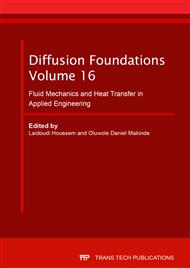[1]
Goldstein, R.J., Eckert, E.R.G., Burggraf, F, Effects of hole geometry and density on three-dimensional film cooling. Int. J. Heat Mass Transf. Pergamon Press 17, (1974) 595–607.
DOI: 10.1016/0017-9310(74)90007-6
Google Scholar
[2]
Walters, D.K., Leylek, J.H, A detailed analysis of film-cooling physics: Part I-streamwise injection with cylindrical holes. ASME J. Turbomach, (2000) 122.
DOI: 10.1115/1.555433
Google Scholar
[3]
Foster, N.W., Lampard, D, The flow and film cooling effectiveness following injection through a row of holes. ASME J. Eng. Power 102, (1980) 584–588.
DOI: 10.1115/1.3230306
Google Scholar
[4]
Haven, B.A., Yamagata, D.K., Kurosaka, M., Yamawaki, S., Maya, T, Anti kidney pair of vortices in shaped holes and their influence on film cooling effectiveness, ASME Paper No. (1997) 97-GT-45.
DOI: 10.1115/97-gt-045
Google Scholar
[5]
Lemmon, C.A., Kohli, A., Thole, and K.A.: Formation of counter-rotating vortices in film-cooling flows ASME Paper No. (1999) 99-GT-161.
Google Scholar
[6]
Nasir, H, Ekkad, S.V., Acharya, S, Effect of compound angle injection on flat surface film cooling with large streamwise injection angle. Elsevier J. Exp. Thermal Fluid Sci. (2001).
DOI: 10.1016/s0894-1777(01)00052-8
Google Scholar
[7]
Lin, Y., Song, B., Li, B., Liu, G, Measured film cooling effectiveness of three multihole patterns. ASME J. Heat Transf. (2006) 128.
DOI: 10.1115/1.2137762
Google Scholar
[8]
McGovern, K.T., Leylek, J.H, A detailed analysis of film cooling physics: Part II-compound-angle injection with cylindrical holes. ASME J. Turbomach. (2000) 122.
DOI: 10.1115/1.555434
Google Scholar
[9]
Jung, I.S., Lee, J.S, Effects of orientation angles on film cooling over a flat plate:boundary layer temperature distributions and adiabatic film cooling effectiveness. ASME J. Turbomach. (2000) 122.
DOI: 10.1115/1.555437
Google Scholar
[10]
Baheri, S., Alavi Tabrizi, S.P., Jubran, B.A, Film cooling effectiveness from trenched shaped and compound holes. Springer Heat Mass Transf. 44, (2008) 989–998.
DOI: 10.1007/s00231-007-0341-9
Google Scholar
[11]
Miao, J.-M., Wu, C.-Y, Numerical approach to hole shape effect on film cooling effectiveness over flat plate including internal impingement cooling chamber. Int. J. Heat Mass Transf. (2006) 49.
DOI: 10.1016/j.ijheatmasstransfer.2005.09.015
Google Scholar
[12]
Gao, Z., Narzary, D.P., Han, Je-Chin, Film cooling on a gas turbine blade pressure side or suction side with axial shaped holes. Int. J. Heat Mass Transf. 51, (2008) 2139–2152.
DOI: 10.1016/j.ijheatmasstransfer.2007.11.010
Google Scholar
[13]
Grizzle, J.P.F.: Film cooling on a flat plate: investigating density and upstream step effects using IR and PSP. M.S. Thesis submitted to Texas A & M University (2008).
DOI: 10.1115/ht2008-56194
Google Scholar
[14]
Azzi, A., Abidat, M., Jubran, B.A., Theodoridis, G.S, Film cooling predictions of simple and compound angle injection from one and two staggered rows. J. Num. Heat Transf. Taylor & Francis Part a 40, (2001) 273–294.
DOI: 10.1080/10407782.2001.10120637
Google Scholar
[15]
Auf dem Kampe, T., et al, Experimental and Numerical Investigation of Flow Field and Downstream Surface Temperatures of Cylindrical and Diffuser Shaped Film Cooling Holes1. Journal of Turbomachinery, 2013. 135(1): p.011026.
DOI: 10.1115/1.4006336
Google Scholar
[16]
Lakehal, D., Near-Wall Modeling of Turbulent Convective Heat Transport in Film Cooling of Turbine Blades with the Aid of Direct Numerical Simulation Data. Journal of Turbomachinery, 2002. 124(3): pp.485-498.
DOI: 10.1115/1.1482408
Google Scholar
[17]
Bergeles, G., A. Gosman, and B. Launder, The Turbulent Jet in a Cross Stream at Low Injection Rates: a Three-Dimensional Numerical Treatment. Numerical Heat Transfer, Part A: Applications, 1978. 1(2): pp.217-242.
DOI: 10.1080/10407787808913373
Google Scholar
[18]
Medic, G. and P.A. Durbin, Toward Improved Film Cooling Prediction. Journal of Turbomachinery, 2002. 124(2): pp.193-199.
DOI: 10.1115/1.1458021
Google Scholar
[19]
Germain, T., M. Nagel, and R. Baier. Visualisation and Quantification of Secondary Flows: Application to Turbine Bladings with 3D-Endwalls. In Paper ISAIF8-0098, Proc. of the 8th Int. Symposium on Experimental and Computational Aerothermodynamics of Internal Flows, Lyon. (2007).
Google Scholar
[20]
Alameldin, A., et al. CFD Analysis of Suction and Pressure Side Film Cooling Influence on Vane Aero Performance in a Transonic Annular Cascade. in ASME Turbo Expo 2014: Turbine Technical Conference and Exposition. 2014. American Society of Mechanical Engineers.
DOI: 10.1115/gt2014-26617
Google Scholar
[21]
Laskowski, G.M., A.K. Tolpadi, and M.C. Ostrowski. Heat transfer predictions of film cooled stationary turbine airfoils. in ASME Turbo Expo 2007: Power for Land, Sea, and Air. 2007. American Society of Mechanical Engineers.
DOI: 10.1115/gt2007-27497
Google Scholar
[22]
Hylton, L., et al., the effects of Leading Edge and Downstream Film Cooling on Turbine Vane Heat Transfer. Final report general motors corp., Indianapolis, IN. ALlision Gas Turbine Div. 1. (1988).
DOI: 10.1115/89-gt-69
Google Scholar
[23]
Zhi Tao, Zhenming Zhao, Shuiting Ding, GuoqiangXu, Hongwei Wu, Suitability of three different two-equation turbulence models in predicting film cooling performance over a rotating blade,, International Journal Heat and Mass Volume 52, Issues 5–6, February 2009, Pages 1268-1275.
DOI: 10.1016/j.ijheatmasstransfer.2008.09.008
Google Scholar
[24]
Deepak Raj P.Y, Devaraj. K, Numerical Heat Transfer Analysis of a Flat Plate using Combined Jet Impingement and Film cooling, with Flow Patterns," International Journal of Engineering Research and Technology. ISSN: 2278-0181.
Google Scholar
[25]
Hasn Nasir, Srinath V. Ekkad, Sumanta Acharya, effect of compound angle injection on flat surface film cooling with large stream wise injection angle .JU. Of experimental thermal fluid Science, (2001) 23-29.
DOI: 10.1016/s0894-1777(01)00052-8
Google Scholar
[26]
A,Kohli, D. Bogard, Adiabatic effectiveness thermal fields and velocity fields for film Cooling with large angle injection, ASME J. Turbomach. 119 (1997) 352-358.
DOI: 10.1115/1.2841118
Google Scholar


